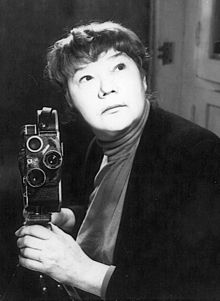Marie Menken
| Marie Menken | |
|---|---|

Marie Menken with her 16mm Bolex
|
|
| Born |
Marie Menkevicius May 25, 1909 New York City, New York, U.S. |
| Died | December 29, 1970 (aged 61) Brooklyn, New York, U.S. |
| Occupation | Experimental Filmmaker |
| Spouse(s) | Willard Maas |
Marie Menken (born Marie Menkevicius, May 25, 1909 – December 29, 1970), was an American experimental filmmaker, painter, and socialite. She was noted for her unique filming style that incorporated collage.
Menken was born in Brooklyn, New York on May 25, 1909, to a Roman Catholic immigrant couple from Lithuania. She studied at the New York School of Fine and Industrial Arts as well as the Art Students League of New York and honed her craft as a painter. To support herself, she worked as a secretary at the Solomon R. Guggenheim Museum before receiving a scholarship from Yaddo and moving to upstate New York.
There is no why for my making films. I just liked the twitters of the machine, and since it was an extension of painting for me, I tried it and loved it. In painting I never liked the staid and static, always looked for what would change the source of light and stance, using glitters, glass beads, luminous paint, so the camera was a natural for me to try – but how expensive!
Menken and her husband Willard Maas began a well-respected avant-garde art group known as The Gryphon Group in the mid-1940s. It was around this time that Menken, bored of the static nature of paint on canvas, began to experiment with film. She released her first film Visual Variations on Noguchi in 1945 to acclaim within the experimental art circles of the time. She used a hand-held and hand-cranked 16mm Bolex camera for this as well as many of her later films, contributing to the spontaneity and agility of her work. Noguchi is a non-narrative film that combines quick, decontextualized shots of the sculptures of Isamu Noguchi with shrill, discordant music.
Menken, along with the Gryphon Group, began to produce numerous short experimental films around the time of Noguchi's release. She also began to experiment with various types of animation techniques, including collage and stop-motion cinematography, owing to her background in painting.
...
Wikipedia
